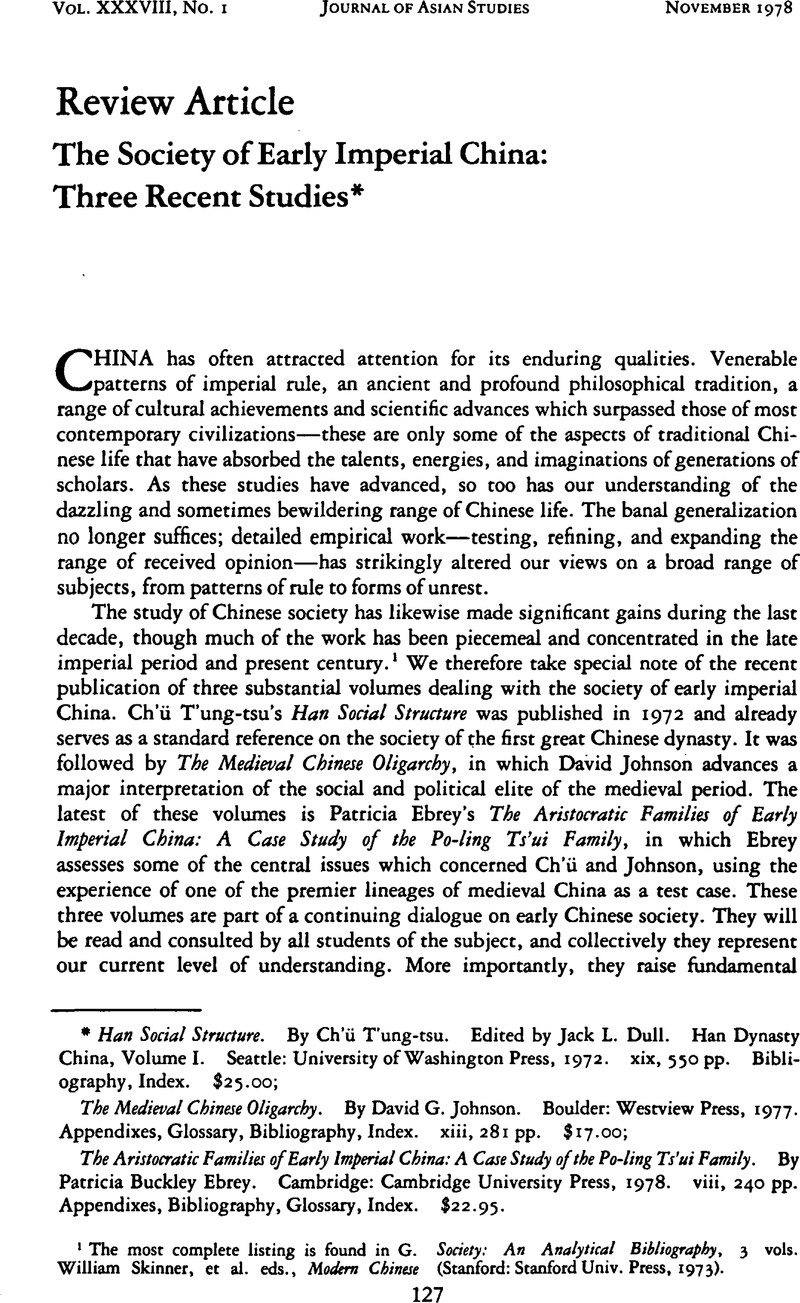Published online by Cambridge University Press: 23 March 2011

1 The most complete listing is found in G., William Skinner, et al. eds., Modern Chinese Society: An Analytical Bibliography, 3 vols. (Stanford: Stanford Univ. Press, 1973).Google Scholar
2 Wittfogel, , Feng, Chia-sheng, et al., History of Chinese Society: Liao (907–1125) (Philadelphia: American Philosophical Society, 1949).Google Scholar
3 The now-classic work is E.J., Hobsbawm, Primitive Rebels: Studies of Archaic Forms of Social Movement in the 19th and 20th Centuries (New York: Norton, 1965).Google Scholar
4 See the discussion in David, Easton, The Political System: An Inquiry into the State o political Science, 2nd. ed. (New York: Alfred A. Knopf, 1971), pp. 96 f.Google Scholar
5 Easton, , “Political Anthropology,” in Bernard, J. Siegel, Biennial Review of Anthropology, 1959 (Stanford: Stanford Univ. Press, 1959), p. 236.Google Scholar
6 See the discussion in Adam, Kuper, Anthropologists and Anthropology: The British School, 1922–1972 (New York: Pica Press, 1974), pp. 70–71.Google Scholar
7 Lawrence Stone, writing in The New York Review of Books, 24, No. 8 (May 12, 1977), 10.
8 The description of these two approaches and the contrast between them is based largely on the discussion in Henry, Selby, “Social Organization,”in Biennial Review of Anthropology, 1971, ed. Bernard, J. Siegel (Stanford: Stanford Univ. Press, 1972), pp. 286ff.Google Scholar
9 For a succinct discussion, see Peter, Caws, “What is Structuralism?” in Claude Lévi-Strauss: The Anthropologist as Hero, ed. E., Nelson Hayes and Tanya, Hayes (Cambridge, Mass.: MIT Press, 1970), pp. 197–214. See also Selby, “Social Organization,” p. 312.Google Scholar
10 Harris, , The Rise of Anthropological Theory (New York: Crowell, 1968), p. 590.Google Scholar Harris makes the contrast in terms of the “emic”/“etic” distinction, which parallels the mentalist/empiricist contrast. Harris pursues the matter in “History and Significance of the Emic/Etic Distinction,” in Annual Review of Anthropology, 1976, ed. Bernard, J. Siegel (Palo Alto: Annual Reviews, Inc.), 1976, pp. 329–50.Google Scholar
11 Pertti, J. Pelto and Gretel, H. Pelto, Anthropological Research: The Structure of Inquiry, 2nd ed. (Cambridge: Cambridge Univ. Press, 1978), p. 62.Google Scholar
12 Bronislaw, Malinowski, Argonauts of the Western Pacific (New York: E.P. Dutton, 1961), p. 25.Google Scholar
13 Emily, M. Ahern discusses the striking difference between the two viewpoints in The Cult of the Dead in a Chinese Village (Stanford: Stanford Univ. Press, 1973), pp. 265–66.Google Scholar
14 This is the phrase used by Marvin Harris; see “History and Significance of the Emic/Etic Dis- tinction,” p. 329.
15 See his review of Chang Chung-li, The Chinese Gentry, in Pacific Affairs 29 (1956), p.
16 Surprisingly, the actual power of court functionaries during this period has not received serious attention; see Albert, E. Dien, “Elite Line-ages and the T'o-pa Accommodation: A Study of the Edict of 495,” in Journal of the Economic and Social History of the Orient, 19, Pt. 1 (1975), 79.Google Scholar
17 On the idea of “total societies,” see the discussion in Richard, N. Adams, “The Study of Complex Societies,” in Crucifixion by Power: Essays in Guatemalan National Social Structure, ed. Richard, Adams (Austin: Univ. of Texas Press, 1970), pp. 30–31.Google Scholar
18 See his, “Levels of Sociocultural Integration: An Operational Concept,” in The Theory of Culture Change (Urbana: Univ. of Illinois Press, 1955)Google Scholar; and The People of Puerto Rico (Urbana: Univ. of Illinois Press, 1956).Google Scholar
19 Wolf, , “Levels of Communal Relations,” in Handbook of Middle American Indians, ed. M., Nash, Vol. 6 (Austin: Univ. of Texas Press, 1967), pp. 299–300.Google Scholar
20 Adams, “The Study of Complex Societies,” pp. 55f.
21 Wolf, “Levels of Communal Relations,” pp. 299–300.
22 See the discussion in Skinner, “Cities and the Hierarchy of Local Systems,” in The City in Late Imperial China, ed. G., William Skinner (Stanford: Stanford Univ. Press, 1977), pp. 281ff. and p. 721 n. 48.Google Scholar
23 Ralph, Linton, The Study of Man (New York: D. Appleton-Century Co., 1936), pp. 113–14Google Scholar; quoted in Ward, H. Goodenough, “Rethinking Status and Role: Toward A General Model of the Cultural Organization of Social Relationships,” in The Relevance of Models for Social Anthropology, ed. Michael, Banton (London: Tavistock Publications, 1965), pp. 1–2.Google Scholar
24 This has been demonstrated even in T'ang times; see Denis, C. Twitchett, “Chinese Social History from the Seventh to the Tenth Centuries: The Tunhuang Documents and their Implications,” in Past and Present, No. 35 (1966), p. 39. Twitchett's discussion stresses the enormous complexity of social and economic relations even among the: poorer rutal classes.Google Scholar
25 Joyce, James, The Portrait of the Artist as a Young Man (London: Jonathan Cape, 1964), p. 245.Google Scholar
26 Easton, “Political Anthropology,” p. 221.
27 For a fuller discussion, see Pelco and Pelto, Anthropological Research, pp. 43f.
28 Sahlins, Marshall, Social Stratification in Polynesia (Seattle: The American Ethnographic Society, 1958), p. 1.Google Scholar
29 One should make special note however of the essay by D.C., Twitchett, “The Composition of the T'ang Ruling Class: New Evidence from Tunhuang,” in Perspectives on the T'ang, ed. Arthur, F. Wright & Denis, Twitchett (New Haven: Yale Univ. Press, 1973), pp. 47–85.Google Scholar
30 “The Last Years of a Great Clan: The Li Family of Chao Chün in the Late T'ang and Early Sung,” Harvard Journal of Asiatic Studies, 37, No. (1977), 5–102.
31 Eric, Wolf, Anthropology (Englewood Cliffs, N.J.: Prentice Hall, 1964), p. 3.Google Scholar
32 Maurice, Freedman, Chinese Lineage and Society: Fukien and Kwangtung (London: The Athlone Press, 1971), p. 155.Google Scholar